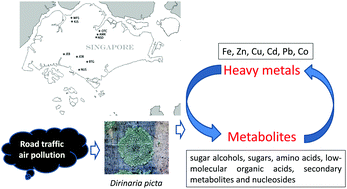Correlations in the elemental and metabolic profiles of the lichen Dirinaria picta after road traffic exposure†
Abstract
Lichens can be used as cost-effective biomonitors of elements from road traffic in the urban environment. However, the nature of comprehensive interactions between hazardous heavy metals from road traffic and lichen metabolites remains unclear. In this study, elemental and metabolic profiles of the lichen Dirinaria picta after exposure to road traffic for 3 months in 9 sites of Singapore city were investigated. Concentrations of 34 elements reveal strong correlations among each other and a general increase with traffic exposure level. A variety of metabolites, i.e. sugar alcohols, sugars, amino acids, low-molecular mass organic acids, secondary metabolites and nucleosides, are identified through a multi-platform approach combining liquid chromatography quadrupole time-of-flight mass spectrometry (LC-QTOF/MS), gas chromatography quadrupole mass spectrometry (GC-Q/MS) and 1H nuclear magnetic resonance (1H NMR). The total amount of the heavy metals Fe, Zn, Cu, Cd, Pb and Co can be significantly correlated with 21 metabolites positively and 9 metabolites negatively. These correlations reveal a heavy metal detoxification mechanism through ROS scavenging, osmoregulation and chelation with N atoms and sulfhydryl groups, as well as depletion of arabitol and inhibited synthesis of certain secondary metabolites such as quinones and steroids due to heavy metal stress. This study provides new insights into the metabolic toxicity and detoxification mechanisms in lichens under heavy metal exposure.



 Please wait while we load your content...
Please wait while we load your content...